Welcome to Consumer behaviour. In this topic, you will learn about:
- Consumer market and buying behaviour
- Cultural factors
- Social factors
- Personal factors
- Psychological factors
- Stages of the buyer behaviour
The consumer market is a term that refers to all the individuals and households that buy or acquire goods and services for personal consumption. The consumer markets’ reasons that encourage the purchase of goods and services are influenced by many buying behaviours. The marketing term, consumer buyer behaviour, refers to the buying behaviour of final consumers that buy goods and services for personal consumption. The following are the five principles of consumer behaviour:
- it is purposeful and goal-oriented
- the consumer has freedom of choice
- it is a process
- it can be influenced
- there is a need for consumer education
It is fascinating to know that different people and groups prefer different items than others, these decisions are influenced by their individual buyer behaviour. These buying behaviours are stimulated by the environment, such as the product, price, promotion and place and other environmental factors, for instance, the macro-environment. The following step in this process of purchasing goods and services is the buyer’s black box, where a decision is formed regarding the purchase. The black box consists of two parts:
- the buyer’s characteristics
- the buyer’s decision process.
The outcome of the thinking process that occurs within the black box is the buyer’s responses and are influenced by factors such as the buying attitudes and preferences. The below image illustrates the buyer’s behaviour process.
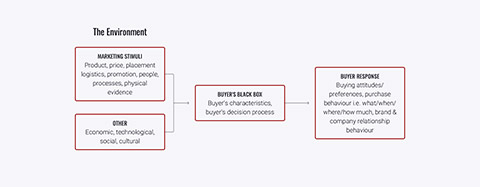
It is essential for marketers to have a sound understanding of what occurs in the customer’s mind within the buyer’s black box, which, in turn, results into a buyer’s response. The buyer’s characteristics play a big role in the consumer’s behaviour process. The following four factors help form the buyer’s characteristics:
- cultural
- social
- personal
- phycological
Have a look at the below illustration of the buyer’s characteristics and its influences.

The following subtopics will help you gain a deeper understanding to each of the buyer’s characteristics and their influences.
The buyer’s black box gets influenced by cultural factors such as the following three:
- culture
- cultural group or subculture
- social class
The following influences are described as follows:
Culture is the most basic contributing factor of a person’s wants and behaviour; it is set of basic values, perceptions, wants and behaviours learned by a member of society from family and other important institutions.
Cultural group or a subculture, is a group of people with shared value systems based on common life experiences and situations.
Social classes are relatively permanent and ordered divisions in a society, whose members share similar values, interests and behaviours.
There are four main influences to the buyer’s social factor, these are:
- consumers’ groups
- family
- social roles
- status
Various groups are formed when two or more people interact to accomplish individual or mutual goals.
An individual’s attitudes and behavior are influenced by many small groups. Below are five examples.
- Membership groups, typically are family, religious and professional groups.
- Reference groups are a group of individuals where buyers might compare themselves against and may strive to be like a popular celebrity, for example.
- Aspirational groups are where an individual does not belong to that group, but would want to be a part of.
- Opinion leaders, these may be people such as influencers, buzz marketing can be used to enlist opinion leaders as brand ambassadors.
- Online social networks the use of social realms to promote their product and build closer relationships with their consumer.
Below is a great case of how marketers used social media successfully to promote a position vacancy. Further information of this case study can be found within your additional resources of this topic.
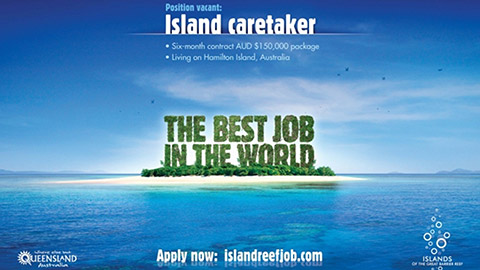
Findings from this case study showed that within six weeks of launching the promotion more than 34,000 applications had been received from nearly 200 countries. The website drew more than 6.8 million unique monthly visitors with nearly 54 million-page views and an astounding average time on site of 8.25 minutes. More than 46,000 mainstream media stories and 230,000 blog posts referred to the promotion reaching an estimated 3 billion people and earning more than $260 million in media value.
BBC would film a documentary about the promotion attracting more than 4 million viewers, and nearly half a million online votes were tallied in selecting the person who would take on the Island Caretaker’s role. This campaign was managed on the back of what remains, a relatively small $1.2 million budget.
There are six personal factors that affect consumer behaviour are:
- age & lifecycle stage
- education
- occupation
- economic circumstances
- lifestyle
- personality & self-concept
Let us look at these in more detail.
Lifestyle is a person’s pattern of living as expressed in his or her activities, interests and opinions, their psyychographics. People coming from the same subculture, social class and occupation may have quite different lifestyles. Lifestyle is a person’s pattern of living as expressed in his or her psychographics.
Examples includes:
- Activities (work, hobbies, shopping, sports, social events),
- Interests (food, fashion, family, recreation) and
- Opinions (about themselves, social issues, business, products).
- Lifestyle captures something more than the person’s social class or personality; it profiles his or her whole pattern of acting and interacting in the world.
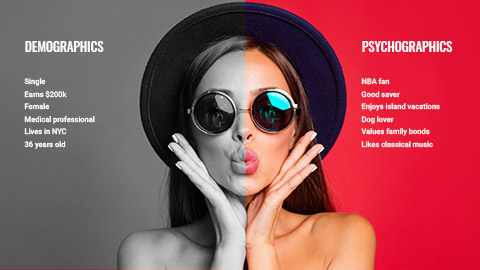
There are different types of lifestyle segmentation such as age, economic situation, life-cycle stage, education and occupation, these are the standard population descriptors of demographics, different to psychographic. Segmentation can be as varied as customer demographics, however, four key groups are typically considered when analysing lifestyle data.
- Geographic Data. Where are the focal groups located? Where are they buying and using the products?
- Behavioral. When are the groups more likely to buy and under what circumstances? How do they choose to consume or use the product?
- Demographics. What are the races, genders, age groups, and marital statuses of your customers/consumers?
- Psychographic. What makes them unique? What are their personal preferences and lifestyle choices?

Personality refers to the unique psychological characteristics that distinguish a person or group. Each person’s distinct personality influences his or her buying behaviour. The idea is that brands also have personalities, and that consumers are likely to choose brands with personalities that match their own. Brand personality is the specific mix of human traits that may be attributed to a particular brand.
Brand personality traits, identified in selected research, include:
- sincerity
- excitement
- competence
- sophistication
- ruggedness
Examples and descriptions can be seen in the following two images.
Brand personality framework

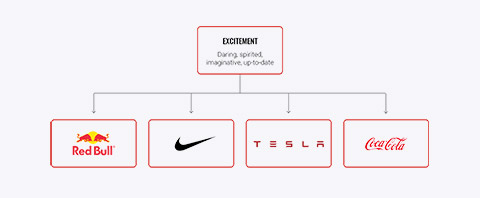
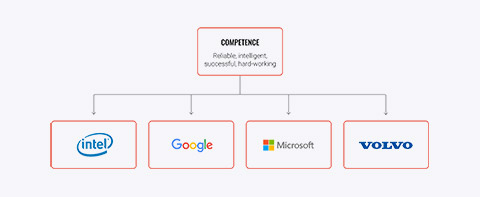
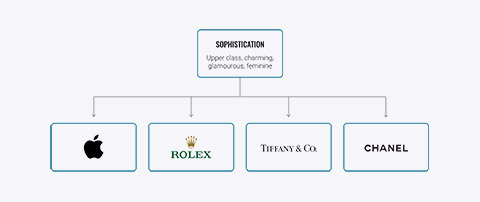
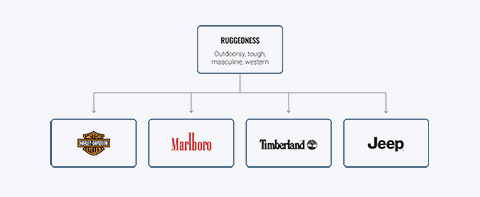
Many marketers use a concept related to personality – a person’s self-concept (also called self-image). The idea is that people’s possessions contribute to and reflect their identities – that is, ‘we are what we have’. Thus, in order to understand consumer behaviour, the marketer must first understand the relationship between consumer self-concept and possessions.
See the following three videos for some brilliant examples of this.
There are five psychological factors affecting consumer behaviour:
- motivation
- perception
- learning
- beliefs
- attitudes
The following influences are described as follows:
Motivation (drive) is a need that is sufficiently pressing to direct the person to seek satisfaction of the need.
Maslow’s Theory of Motivation is sought to explain why people are driven by particular needs at particular times. Have a look at this theory in the illustration below.

Motivation research refers to qualitative research designed to probe consumer’s hidden, subconscious motivations. For instance, an ageing baby boomer who buys a sports car might explain that he simply likes the feel of the wind in his hair. At a deeper level, he may be buying the car to feel young and independent again.
Perception is the process by which people select, organise and interpret information to form a meaningful picture of the world. An individuals’ perception helps buyers give meaning to their environment. See three examples of perception of consumers.
See three examples of perception of consumers.
- Selective Attention: consumers are constantly bombarded with information and will screen out stimuli.
- Selective Distortion: messages do not always come across in the same way the sender intended.
- Selective Retention: people will forget much that they learn, but will tend to retain information that supports their attitudes and beliefs
Learning refers to the changes in an individual’s behaviour arising from experience, when people act, they learn. Learning describes changes in an individual’s behaviour arising from experience. Learning theorists say that most human behaviour is learned. The consumer’s learning factor has an influence on their learning effect, additionally, on the practical result of a marketing strategy.
Belief is a descriptive thought that a person holds about something. Beliefs may be based on real knowledge, opinion or faith, and may or may not carry an emotional charge.
Marketers are interested in the beliefs that people formulate about specific products and services because these beliefs make up product and brand images that affect buying behaviour. If some of the beliefs prevent purchase, the marketer will want to launch a campaign to correct them.
Attitudes, however, are difficult to change, thus, companies generally try to fit their products into existing attitudes rather than attempt to change attitudes.
Attitude refers to a person’s consistently favourable or unfavourable evaluations, feelings and tendencies towards an object or idea. There are three main components of attitude that influence the consumers behaviour.
- Cognitive Component: Your thoughts and beliefs about the subject
- Affective Component: How the object, person, issue, or event makes you feel
- Behavioural Component: How attitude influences your behaviour

There are five stages of the buyer’s decision process that describes the journey a customer takes before making a purchase, this can also be known as the customers’ buying process. See the below image and explanation of this process.

Click on each step to see the description.
The buyer recognises a need, triggered by internal or external stimuli.
The buyer seeks out information about products or services with potential to satisfy the need.
The consumer processes information in order to arrive at brand choices.
The consumer forms a purchase intention and ultimately makes the actual purchase.
Following the purchase, the consumer will engage in a variety of post-purchase behaviours – including satisfaction, formation of future purchase intentions and loyalty intentions. The smaller the gap between customer expectations and perceived performance, the greater the customer’s satisfaction Cognitive dissonance is buyer discomfort caused by post-purchase conflict. Second-guessing your choice: food in restaurant, car, mobile phone.
Looking further into the evaluation of alternatives, you will find that a customer will go through another sub-process before reaching a decision. An example of this process illustrated below.

Best Practices
- Consumers often view price as an indication of quality
- Dissatisfied customers may not complain
- Employees must seek out consumer dissatisfaction.
Roles in the buying process
Buying roles refers to the activities that individuals may perform in a buying decision, for example:
- initiator is the person who first suggests the idea of buying a product or service.
- influencer is the person or persons whose views carry some weight in the final purchase decision.
- decider is the person who makes the final buying decision, or any part of it (e.g. brand, place of purchase, quantity).
- buyer is the person who makes an actual purchase
- user is the person who uses or consumes the product or service
When purchasing a new product the process is different. The buyer decision process for new products can be seen in the illustration below.
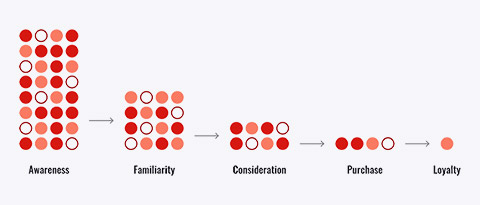
Consumers go through five stages in the process of adopting a new product:
- awareness
- interest
- evaluation
- trial
- adoption
The Consumer Decision Journey – McKinsey Model
Based on the complexities of today’s markets, consumers are changing the way they research and buy products. McKinsey developed the following consumer decision journey in 2009, more information on The McKinsey Model is found within this topics’ additional resources at the end of this topic.
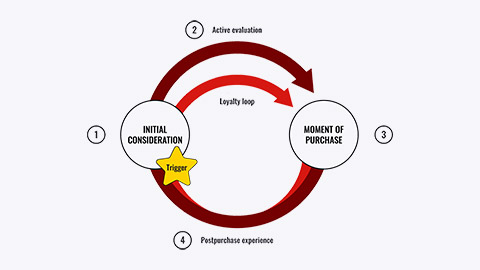
- The consumer considers an initial set of brands, based on brand perceptions and exposure to recent touch points.
- Consumer ad or subtract brands as they evaluate what they want.
- Ultimately, the consumer selects a brand at the moment of purchase.
- After purchasing a product or service, the consumer builds expectations based on experience to inform the next.
End of topic forums
There are forum activities for this topic. Select the ‘Forum’ at the end of your module (which can be found within your navigation menu) and follow the instructions for each question pertaining to 4 within the forum.
Read the following case study where marketers aimed their marketing to a global audience The Best Job in the World – Tourism Queensland case study
Read the following two articles derived from The McKinsey.
Ten years on the consumer decision journey where are we today
Further reading

